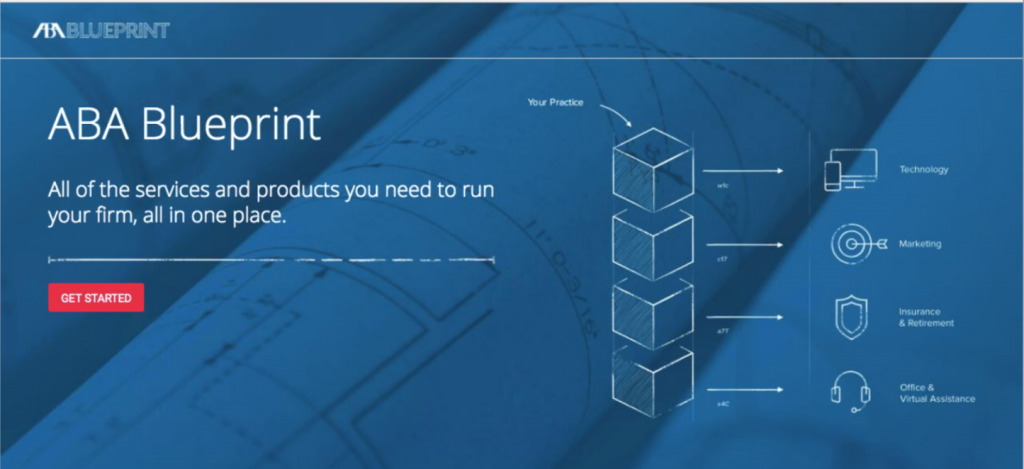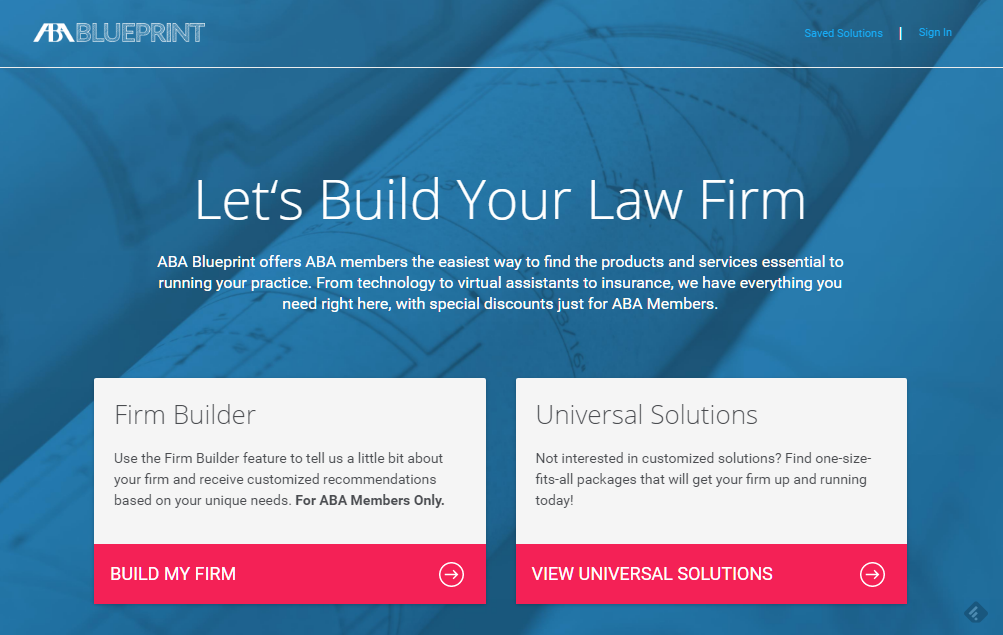The American Bar Association today is launching ABA Blueprint, its website designed to help solo and small firm lawyers manage the complexities of their legal practices by helping them find the products and services they need at affordable prices.
As I reported here in August, plans to develop the site were first announced by ABA President Linda A. Klein in a speech to the ABA House of Delegates during the ABA Annual Meeting in San Francisco. The site will provide lawyers with a “one-stop shop for members to get what they need while saving far more than they pay in dues,” she said then.
“The ABA will enhance our resources that help our members — especially solo practitioners and those in small firms — with marketing, managing their practices and getting out ahead of what’s new in technology,” Klein said in August.
Also in August, I was given a preview of the site by Nicole Bradick, chief strategy officer at CuroLegal, the legal strategy and technology consulting firm that the ABA hired to build Blueprint. Yesterday, I spoke again with Bradick, as well as with CuroLegal CEO Chad Burton, for a demonstration of the site being launched today.
The site is intended to be used by all solo and small firm attorneys, but ABA members get access to special services and product discounts through the site.
Help Building A Firm
The idea of the site is to help lawyers choose the products and services they need to build their firms. Lawyers who come to the site are given two routes by which to do this.
The first, called Firm Builder, is restricted to ABA members and is intended to provide customized recommendations based on the user’s unique needs. The user first chooses a category — technology, virtual assistance or marketing — and then answers a series of questions. The result is a set of recommended products and services.
The other route, called Universal Solution, is open to anyone and offers one-size-fits-all packages tailored to these needs:
- Start a firm now.
- Help me get paid.
- Help me grow.
- Help me build a team.
- Help me with eDiscovery.
- Help me insure my future.
A user can click on a product to read a more detailed description and can then click through to the vendor’s site to purchase the product. Product descriptions also show the savings available to ABA members.
A third option option available exclusively to ABA members through the site is to contact a practice-management consultant. Members can schedule a free 30-minute consultation by phone or get quick answers via live chat between the hours of 9 a.m. and 3 p.m. Eastern time.
Selective List of Vendors
The ABA intends that the menu of products and services offered through the site is to be selective and reflect essential core products within each category.
As of today’s launch, the menu of products is too limited, in my opinion. For example, the site offers only one practice management platform, Clio, and only one accounting system, QuickBooks Online. As a matter of fact, the site offers only 13 products in total that I could find. They are:
- Clio.
- Office 365.
- LawPay.
- Quickbooks Online.
- Lexicata.
- MailChimp.
- LexBlog.
- Ruby Receptionists.
- Fancy Hands.
- eDiscovery Assistant.
- PageVault.
- ABA Insurance.
- ABA Retirement Funds Program.
Burton and Bradick told me that the initial group of companies were selected based on their standing in the marketplace and their capacity for integrations with other products than can provide lawyers with the tools they need to run a practice.
“For this initial roll-out, we looked at the different categories and wanted to be able to provide one solution per category,” Burton said, “so the user could go in and get started with a wide variety, whether with human side products or virtual assistants or even insurance.”
They are already working to add additional vendors but they also want to receive user feedback on recommended products and services. The FAQ page includes a link for users to recommend products they would like to see.
Discounts on Products
A notable advantage of using the site is the discounts it offers. Take Clio, for example. Clio has three levels of monthly subscriptions (with an annual contract) — $39, $59 and $99. Blueprint offers 25 percent discounts off Clio’s top two tiers, so the $69 tier would be $51.75 and the $109 tier would be $81.75. That is an annual savings of $207 or $327.
Ruby Receptionists is offering a new Solo Plan through Blueprint that is not available through the company’s own website. The solo plan is $180 a month, compared to the lowest-priced plan on the company’s website, which is $259 a month. (For some reason, Blueprint lists $259 a month as the discount price for the same plan that is $259 a month on the Ruby Receptionists’ website.)
Clearly, the ABA intends the members-only features of this site to provide an incentive for non-members to join. The fact is, the ABA appears to be right about this. Consider that ABA dues for a solo lawyer range from $117 to $260 (depending on year of bar admission). Just the Clio discount alone could make back the price of the dues. If you buy other products as well, then the savings become even greater.
Bottom Line
ABA President Linda should be commended for taking the initiative to address the practical needs of solo and small firm lawyers through a site tailored to helping them build their practices. The site needs more vendors added to the mix — particularly in order for the Firm Builder component to make truly customized recommendations — but the ABA is right to get the site up and running rather than wait for it to be perfect.
“This is a good example of how a bar can move quickly on something,” Burton said yesterday. “This is not something that required 10 years of thought. We know the problems out there. We know solos and smalls are having problems figuring out how to start a practice. Lets get it going and then it evolves from there.”
Can’t argue with that.
 Robert Ambrogi Blog
Robert Ambrogi Blog
